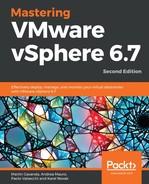Many features can be used for guest OS or application clustering within VMware vSphere. There are always pros and cons for each type depending on your use case:
- SCSI bus sharing for virtual disks on VMFS volume: You can enable simultaneous access to the single disk for multiple VMs
- SCSI bus sharing for RDM devices: In this case, there is no virtual disk located on the VMFS datastore, but the device is mapped using Raw Device Mapping (RDM) as a disk to the VMs
- Multi-writer flag on the virtual disk: No bus sharing is involved, but the disk is unlocked for simultaneous operations from the VMs
- In-guest iSCSI: There is no shared disk on the vSphere level, the disk is mapped from the guest OS.
Although VMware vSphere supports different storage configurations that can be used for clustering, always check the vendor or VMware knowledge base to check if your application supports such configuration. If something can be configured and works as expected, it does not mean that such a configuration is fully supported. For example, with Microsoft Windows Server Failover Clustering (WSFC), you can configure bus sharing for the disks located on the VMFS volume (no RDM), but it is supported only for CiB deployment, not CAB, although it works.
The following are the supported shared storage configurations:
| Storage type | CiB | CAB | VM and physical |
| Virtual disks | Yes | No | No |
| Pass-through RDM (physical compatibility mode) | No | Yes | Yes |
| Non-pass-through RDM (virtual compatibility mode) | yes | No | No |
Cluster-related configuration parameters are as follows:
- SCSI Controller settings:
- Disk types: You have the choice of VMDK, virtual RDM (virtual compatibility mode), or physical RDM (physical compatibility mode).
- SCSI bus-sharing setting: Virtual sharing policy, or physical sharing policy, or none.
- SCSI bus sharing values:
- None: Used for disks that aren't shared in the cluster (between VMs) or when a multi-writer flag is used.
- Virtual: Use this value for CiB deployments.
- Physical: Recommended for CAB or physical and virtual deployments.
- Raw Device Mapping (RDM) options:
- Virtual compatibility mode: In this situation, RDM acts identically to the virtual disk file, and you can use standard virtual disk benefits such as cloning or snapshots.
- Physical compatibility mode: In this situation, RDM has direct access to the SCSI device. This mode is especially usefully for applications that need low-level control over the device.
Please note that your operating system and application must be cluster-aware. You can only map the same disk to multiple VMs assuming both of them will have read/write access to the device.
When working with cluster configuration, always follow the official configuration guide of the vendor of the application or the operating system. Any misconfiguration can lead to serious cluster issues or event data corruption.
